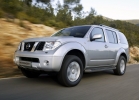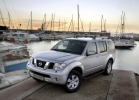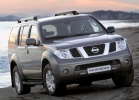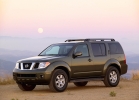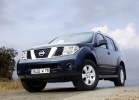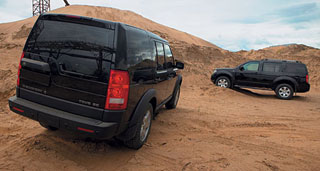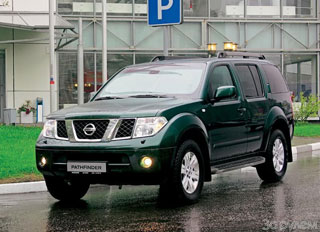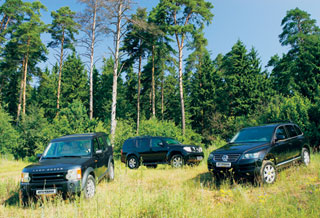Test drive Nissan Pathfinder 2005 - 2007 SUV
The peers of the century
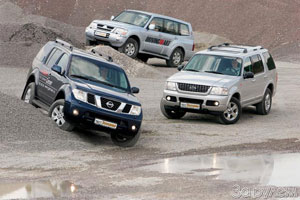 Cars are changing. At least the others are affected by the trends
Cars are changing. At least the others are affected by the trends Modern trends dictate a complete refusal of dependent suspensions with them to achieve good handling and smoothness. Not so much reliability in difficult operating conditions comes to the fore as real convenience in everyday situations. Therefore, comfort, capacity, behavior on roads with hard surface will be in our first roles. Who is faster, more economical, who is better than managing the devices and roads of the training ground. However, we will not forget about the off -road soil climbs and gravel scree will replace the dirt on the hub. The shoes are too different in our wards.
Ford Explorer 4.6 V8 Limited
Ford Explorer is one of the most popular SUV in the USA, but in Europe its presence is almost imperceptible. Built for the sake of tastes of the American public, he combines external solidity with moderate price and highway.
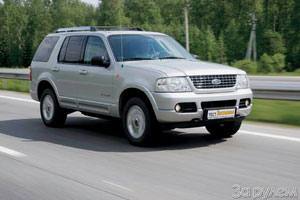 In the United States, its cost is from 25 thousand dollars, and the machine in the Limited with a V-shaped eight, as in our test, costs 32 thousand there. We have almost 50. Unplicatity in Europe is obvious without a diesel engine Explorer too expensive in operation. In our trips, even with an economical style in suburban conditions, more than 12 l/100 km was obtained. Well, urban traffic jams do not allow to spend less than 18 l/100 km. Lovers to use the dynamic qualities of the machine can safely add 3040% in this case 85 liters of ninety -second is barely enough by 400 km. Of course, we have not yet European prices for gasoline, but the thousand -ruble gas stations have pretty well patted our travel budget.
In the United States, its cost is from 25 thousand dollars, and the machine in the Limited with a V-shaped eight, as in our test, costs 32 thousand there. We have almost 50. Unplicatity in Europe is obvious without a diesel engine Explorer too expensive in operation. In our trips, even with an economical style in suburban conditions, more than 12 l/100 km was obtained. Well, urban traffic jams do not allow to spend less than 18 l/100 km. Lovers to use the dynamic qualities of the machine can safely add 3040% in this case 85 liters of ninety -second is barely enough by 400 km. Of course, we have not yet European prices for gasoline, but the thousand -ruble gas stations have pretty well patted our travel budget. Compared to the previous generation, independent suspensions in a circle allowed the explorer to lose 140 kg, reducing the unsubstantiated masses. This, undoubtedly, should affect comfort and controllability in the best way, but
Comfortable settings of Ford pendants allowed the photographer to take the largest number of sharp pictures, but for the driver they can hardly seem optimal.
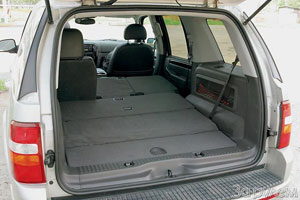 On a winding suburban road with traditional waves, Explorer retained confidence hardly up to 100 km/h. As soon as Ford was passing this mark, the management resembled the struggle of the yacht with a storm. The two -ton omniporrhea swayed and strove to soak into the air in the most inappropriate place all the efforts of the chassis to keep the wheels in constant contact with the road turned out to be vain. If you apply an empty, non -informative steering wheel and a viscous long -flowing brake pedal on this picture, then it is already scary to go faster than 120 km/h. Right, limiting the maximum speed of 160 km/h seems to be a reasonable and not at all a cruel measure of security, even for relatively even roads.
On a winding suburban road with traditional waves, Explorer retained confidence hardly up to 100 km/h. As soon as Ford was passing this mark, the management resembled the struggle of the yacht with a storm. The two -ton omniporrhea swayed and strove to soak into the air in the most inappropriate place all the efforts of the chassis to keep the wheels in constant contact with the road turned out to be vain. If you apply an empty, non -informative steering wheel and a viscous long -flowing brake pedal on this picture, then it is already scary to go faster than 120 km/h. Right, limiting the maximum speed of 160 km/h seems to be a reasonable and not at all a cruel measure of security, even for relatively even roads. The dynamics of acceleration of the lung in the test of a car with the most powerful engine was supposed to push it to a leading position, but a five -stage automatic machine pumped it up. The logic of its switching arranged only with leisurely movement, and taking into account the significant superiority over competitors in power, the advantage over them was not impressed in acceleration.
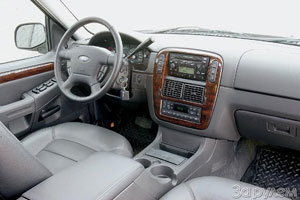 The driver’s place was performed in the best American traditions with a poker of the gearbox selector on the steering column. The left steering wheel switch is overloaded with functions, but leather seats are certainly with electroregulation and memory. Wooden inserts in the interior will diversify black skin and modest plastic. Both in front and behind the passengers of moderate dimensions are spacious. Even on the folding seats of the third row, a couple of adult passengers are accommodated.
The driver’s place was performed in the best American traditions with a poker of the gearbox selector on the steering column. The left steering wheel switch is overloaded with functions, but leather seats are certainly with electroregulation and memory. Wooden inserts in the interior will diversify black skin and modest plastic. Both in front and behind the passengers of moderate dimensions are spacious. Even on the folding seats of the third row, a couple of adult passengers are accommodated. Road clearance and other parameters of the geometric cross -country ability of Explorer are also inferior to competitors. He has below the rear suspension levers, the fuel tank and motor compartment are not protected. More often than others, the car struck on bumps with a rear bumper and a powerful towing device.
Three buttons on the front panel suggest an automatic or forced connection of the front bridge and a reduced gear. To turn on the latter, you need to stop and choose a neutral, otherwise the car will not execute your command. By the way, instead of an intericental differential, an explorer has a multi -disc clutch, which strictly connects the front -wheel drive.
Ford Explorer 4.6 V8 Limited
The second generation of Ford explorer debuted 11 years after the first in January 2001 at the Detroit car dealership. Engines: gasoline V6 and V8, 4.0 and 4.6 liters
Mitsubishi Pajero Di-D
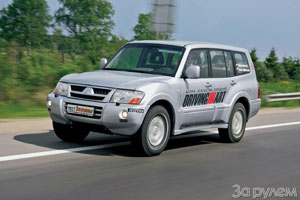 The only presented cars with a supporting body. He promises a minimum of mass and heights, but in fact, Pajero is not the lowest and heavier. However, this severity is evenly distributed along the axes, and only with full loading a large mass falls on the rear wheels. A 3,2-liter turbodiesel adds a fair amount of load on the front, specially released in the Euro II standard (instead of Euro III). This is less sensitive to fuel quality and at the same time a little more powerful.
The only presented cars with a supporting body. He promises a minimum of mass and heights, but in fact, Pajero is not the lowest and heavier. However, this severity is evenly distributed along the axes, and only with full loading a large mass falls on the rear wheels. A 3,2-liter turbodiesel adds a fair amount of load on the front, specially released in the Euro II standard (instead of Euro III). This is less sensitive to fuel quality and at the same time a little more powerful. Pajero’s driver's seat is distinguished by a good range of adjustments and convenient forms for drivers of different lining. In addition, the front seats Mitsubishi are infected, which allows you to make a ride more comfortable.
Pajero pendants seemed the most comfortable. The car copes well with the waves and chips of asphalt, can move with a moderate pace on a broken primer, maintaining the stability and contact of the wheels with the road. The supply of energy intensity for high -speed driving through the crossed terrain is not always enough, but Mitsubishi deserves an excellent assessment as a compromise for all types of roads.
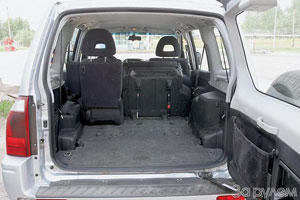 Tires with a large pattern of the tread that were on our car adjusted the character of the car, adding smoothness and validity. The severity on the go is felt, but there are a little small turboyam to the Pajero engine, but its edges are not at all steeps.
Tires with a large pattern of the tread that were on our car adjusted the character of the car, adding smoothness and validity. The severity on the go is felt, but there are a little small turboyam to the Pajero engine, but its edges are not at all steeps. On a small ascent, the motor draws even with 1000 rpm, but it really comes to life after 1,500. It does not grow sense in promoting it above 4000, and the noise is already superior to comfortable limits. Unfortunately, the lever of the mechanical box does not provide for rapid switching. Its selectivity requires addiction. However, on the highway, these problems disappear in most cases, you can roll and accelerate in the fifth gear. Fuel consumption is surprisingly modest about 9 l/100 km.
Both on the asphalt and on the lancinity the transmission super-seal allows you to choose the right mode with the help of a single lever. The rear -wheel drive for pure asphalt, full with an interaxial differential for a slippery road, full with differential locks and lowering gear for gravel dumps.
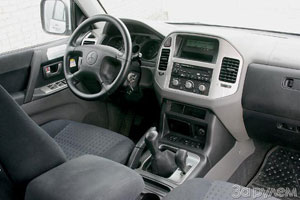 When one of the rear wheels soars into the air, the last reserve is a hard locking of the rear axle.
When one of the rear wheels soars into the air, the last reserve is a hard locking of the rear axle. The reserve on the back door freed a place in the trunk for a folding third row of seats. That's just the seat itself is extremely inconvenient. An adult sits apart.
Mitsubishi Pajero Di-D
Presented in the fall of 1999. Available with a 3- and 5-door body.
Engines: gasoline V6 with direct injection of 3.5 liters (202 hp), diesel with a turbocharged 3.2 liter (165 hp).
Gearboxes: mechanical and automatic
5-speed.
Complete: GLS, Exclusive.
Price in Russia: $ 47 990 50 950.
Nissan Pathfinder 2.5 DCI
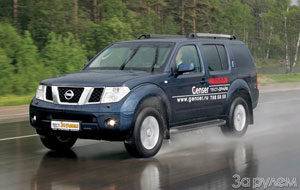 The promising newcomer from Nissan finally reached us. This car is produced for both the American and European markets. Previously, the PasFainer (in Russian of the trackers) was the prerogative of America. In Europe, in this class, Nissan Terrano II/›Terrano II previously performed.
The promising newcomer from Nissan finally reached us. This car is produced for both the American and European markets. Previously, the PasFainer (in Russian of the trackers) was the prerogative of America. In Europe, in this class, Nissan Terrano II/›Terrano II previously performed. Of course, the designers of the new Nissan took into account most of the modern trends. In size, the passfirer is noticeably larger than Pajero. In the pluses, the luggage compartment and an impeccable seats folding scheme are rectangular in plan. We will explain the small shortage of the place above the head of the driver with a complete set: the hatch in the roof conceals about 40 mm of height.
There are a massive front in the lower part to look at the sight of the driver's place. The front stands of the body significantly interfere with steep turns and with maneuvers in the parking lot. In the back, full space and unexpected convenience of landing due to the original shape of the doors, noticeably expanding upward.
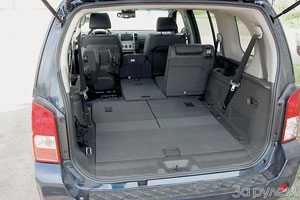 The third row of seats is gracefully hidden on the floor and, if necessary, is suitable for full -sized passengers, although it is noticeably inferior to Fordovsky. Lovers to drive along traveled primers will undoubtedly delight the abundance of inner pens, for which you can grab on a bumpy road. But the pretty circles of the control of the climate installation are not as convenient as it seems. Due to the low height, use them unpriting.
The third row of seats is gracefully hidden on the floor and, if necessary, is suitable for full -sized passengers, although it is noticeably inferior to Fordovsky. Lovers to drive along traveled primers will undoubtedly delight the abundance of inner pens, for which you can grab on a bumpy road. But the pretty circles of the control of the climate installation are not as convenient as it seems. Due to the low height, use them unpriting. Nissan does not share the concept of Mitsubishi in terms of the carrier of the body of the numerous levers of independent pendants are attached to a separate frame, on which, in turn, the body is installed. At the same time, the transfident turned out to be 140 kg easier. Naturally, the new car needed a new engine. With a working volume of 2.5 liters
The reckoning of high characteristics at a large pressure pressure of a narrow operating range, which is nevertheless successfully used by a five -speed automatic. On the road, the box rarely allows the tachometer arrow to fall below 2000 rpm, lingering in lower gears for a long time, so that the car's reaction to the gas pedal is always very peppy. Fans of a calmer management manner will have to take the selector in the hand and choose the fifth ahead of schedule. Similarly, a small and unusually sharp and unusually sharp steering wheel destroys the stereotype of the control of a large and heavy car.
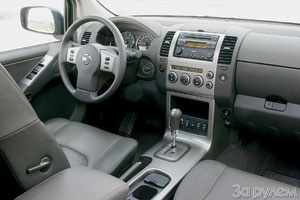 Nissan answers surprisingly hastily to the actions of the driver.
Nissan answers surprisingly hastily to the actions of the driver. Each medal has a flip side in this case, it is smooth. Chips and minor bumps of the highway are unexpectedly felt in the cabin, but on the road Nissan holds on as glued. There is enough energy intensity on a broken primer, but comfort again leaves much to be desired by the rigidity of the suspensions that will not always replace large moves. The same on rough terrain without turning on electronic locks car with hanged wheels quickly becomes real estate.
The ALL-Mode 4x4 all-wheel drive system offers all reasonable options: rear-wheel drive, all-wheel drive with an intended differential, as well as blocking the latter and a reduced gear with a serious number of 2.6.
Nissan Pathfinder 2.5 DCI
Presented in the spring of 2005.
Engines: gasoline V6 4.0 liters (269 hp), diesel with a turbocharged 2.5 liter (174 hp). In Russia, only diesel.
Gearboxes: mechanical 6-speed and automatic 5-speed.
Complete: XE, SE, LE.
Price in Russia: $ 44 800 56 450
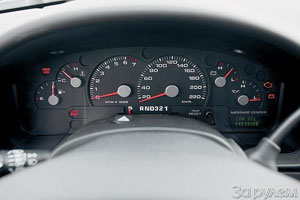 Does the tires decide everything?
Does the tires decide everything? What is the manner of putting on? This task is especially complicated, if you rarely have to ride in dirty primers.
Michelin LTX pilot, in which Ford was shod, provided him with minimal rolling resistance, the lowest noise level and a minimum of cross -country ability in soil. The compromise of Nissan Hudir Rangler NR helped him reveal the potential in braking and handling on the asphalt, but in the sand these tires were almost as helpless. Finally, Mitsubishi, shod in the toothy BF Boss T/A showed the best off -road results, but pretty much lost on the asphalt: the adhesion qualities of tires are not withstanding critics here.
Put your priorities when choosing tires, because for our cars it is only 2% of the price. (205239 hp). Gearbox: automatic 5-speed. Complete: XLT, LIMITED. Price in Russia: $ 44 520 51 720. The four-cylinder Nissan diesel develops power and torque large than the 3.2-liter Mitsubishi engine, while fitting into the strict EVRO IV standards.
Where to put the spare tire?
The spare wheel of the all -terrain vehicle is large, heavy and successfully does not want to compare. The main methods of attaching two on the back door (if it opens to the side) or under the floor of the trunk, then the door can be lifted upward. Ford and Nissan went along the second path, providing an easy scheme that protects from the rain, by the way, with an additional glass opened. Mitsubishi preferred a spare to the door, saving a place for trunk.
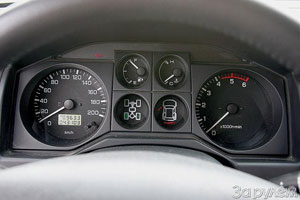 The design with a reserve on the back door is the simplest, but not every current driver will cope with a 30-kilogram wheel, which must be raised to chest level. Horizontal underground sparelights are equipped with a mechanism for lifting and formally require less effort to remove and installations. In fact, pulling the wheel from under the car is not at all easier. And with a hind and dirty road lowered, this is a task at all, stimulating creative thinking and innovative word formation.
The design with a reserve on the back door is the simplest, but not every current driver will cope with a 30-kilogram wheel, which must be raised to chest level. Horizontal underground sparelights are equipped with a mechanism for lifting and formally require less effort to remove and installations. In fact, pulling the wheel from under the car is not at all easier. And with a hind and dirty road lowered, this is a task at all, stimulating creative thinking and innovative word formation. Test cars:
Ford Explorer 4.6 V8 Limited
4.6 l, 239 hp, automatic gearbox, Limited equipment, $ 49 320.
Mitsubishi Pajero Di-D
3.2 l, 165 hp, a mechanical gearbox. GLS equipment, $ 47 990.
Nissan Pathfinder 2.5 DCI
2.5 l, 174 hp, automatic gearbox. Complete LE, $ 53 750.
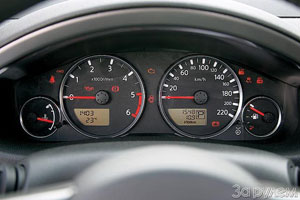 SUMMARY
SUMMARY Ford Explorer one hundred percent American: the first tractor on Highve. To satisfy the driver’s ambitions or real transportation, the explorer is not the best choice.
General assessment
7,2
+ Convenient seats of the third row, high equipment, silence in the cabin, convenient planting on the second row of seats, the possibility of towing the trailer up to 3.5 tons.
- slurred work of the gearbox, poor stability on an uneven road, insufficiently informative steering wheel and brakes, high gasoline consumption, moderate geometric cross -country ability.
SUMMARY
Mitsubishi Pajero is still one of the best compromises between road and off-road qualities. However, age already makes itself felt.
General assessment
7,8
+ Convenient driver's seat, good visibility, high smoothness, the largest suspension moves, a spacious trunk, a complete set of transmission modes, rigid blocking of the rear differential, low fuel consumption.
- modest dynamics, tightness on the seats of the third row, noisy tires, uncomfortable footboards, low selectivity of the gearbox lever.
SUMMARY
Nissan Pathfinder attempt to cross utilitarian values \u200b\u200band the pleasure of driving was successful, although with the loss of a part of off -road qualities.
General assessment
7,8
+ Convenient driver’s place, a large transformable trunk, exemplary handling, nimble automatic, modern interior design.
- small suspension moves, a limited view of the forward, a small working range of diesel, mediocre smoothness, lack of mechanical blocking of the rear differential.
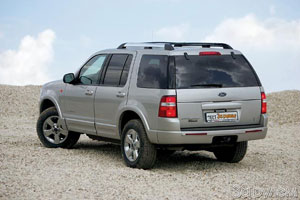
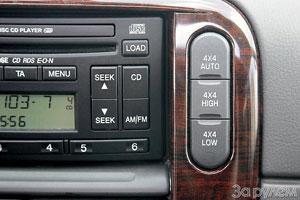
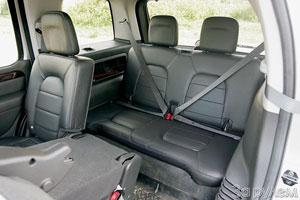
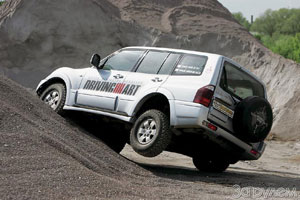
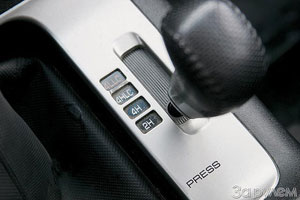
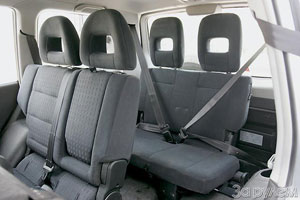
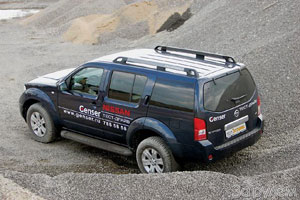
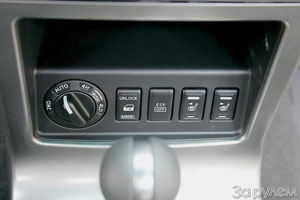
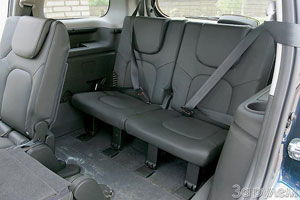
Anatoly Fomin
A source: The magazine "Driving"
Nissan Pathfinder Crash Video Crash tests - 2007
Nissan Pathfinder test drives - 2007
Nissan Pathfinder Krash Test - 2007
Krassh Test: Detailed Information32%
Driver and passengers
18%
Pedestrians
32%
Children-passengers

